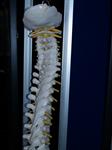Recognising Back Injury
How to Recognise Back Injuries
 While you may not be able to fully diagnose and treat back injuries, there are some symptoms to be looking for either in yourself, or in those around you, that can indicate a back injury. Because of the difficulty in treating back injuries, prevention, and if that fails, early detection, are key.
While you may not be able to fully diagnose and treat back injuries, there are some symptoms to be looking for either in yourself, or in those around you, that can indicate a back injury. Because of the difficulty in treating back injuries, prevention, and if that fails, early detection, are key.
Symptoms of a Spinal Injury (Bone)
Vertebral fractures can result in:
- A sudden onset of back pain, which is eased by lying down;
- Deformity (bulge or indentation in the immediate area);
- Tilting of the hips (one leg will seem shorter than the other, or possibly the leg will twist;
- Height loss and/or shoulder displacement;
- Limited and/or painful spinal movement (standing painful).
Sublaxation or dislocation will result in:
- Symptoms (often vague) in the region that the affected nerves run to
Pain (a later symptom with subluxation, indicating secondary muscle or nerve injury);
- Deformity, tilting of the hips, shoulder displacement and/or pain with certain movement.
Stenosis can result in:
- Most cases affect the lumbar spine, with symptoms presenting at 50+ years of age;
- Pain with standing, relieved with sitting;
- Pain radiating down through buttocks and legs;
- Tingling, sensation changes;
- Weakness, motor function compromised (walking is difficult, for example).
Disc injury will result in varying symptoms, depending on the location and severity:
- No nerve pinching – no symptoms or generalised low back pain
Where nerve is involved:
- Muscle spasms, pain with certain movements in specific locations:
Lower lumbar spine = sciatica, generally in one leg only and may be intermittent;
Upper lumbar spine = pain in front of thigh;
Cervical spine = neck, shoulder or arm pain, tingling, numbness or weakness;
Cauda equine syndrome = both legs affected with loss of bladder and/or bowel control. An extremely serious condition, without urgent medical treatment a person will die.
Symptoms of a Muscular Back Injury
As with injuries to the bony structures of the spine, the symptoms are extremely variable, depending on the affected muscle and the severity of the injury.
Generally, there is:
- Localised pain;
- Localised heat (skin may appear red and hot to touch) and inflammation (swelling);
- Bruising (may be delayed);
- Pain with certain movements, or loss of mobility.
With severe injuries, deformations as the muscle can no longer support the weight of the arms, shoulder etc (associated bones, ligaments and tendons may become dislocated).
If tendons snap the pain is excruciating and you may actually hear a snapping noise
Minor injuries can sometimes be difficult to detect, heat may be masked by raised body temperature from exercise, and pain may be masked by adrenaline, often the injury is noticed several hours after exercise.
Symptoms of a Neurological Back Injury
Symptoms seen with neurological injuries depend on the location, severity and cause. They are almost always the result of a separate injury, such as a disc injury, spinal fracture or severe muscle injury.
A nerve injury will show up as:
- Sensation changes such as tingling, pins and needles, pain (sensory nerve affected);
- Motor changes such as weakness, loss of or impaired movement;
- Combinatorial sensory/motor symptoms such as trouble breathing, paralysis, altered consciousness, dizziness, seizures.
Often in injuries to the nerves at the region where they exit the spinal cord result in pain that runs in a long line, such as sciatica, where pain runs down from the spine, through the buttocks and down into the leg.
This is because the nerves in the periphery (not in the brain) are long single cells, and pain is being felt along their entire length. You can determine the approximate location of the injury causing the neurological symptoms using the symptoms themselves.
Symptoms of Cervical Spine Injury
- Pain with breathing, coughing, lowering chin to chest, twisting the torso, bending to the side, moving arms or shoulders, turning head.
Symptoms of Thoracic Spine Injury
- Pain when leaning forward or backward, pain in the loin region, pain with twisting torso movements or abdominal exercises, abdominal pain.
Symptoms of Lumbar Spine Injury
- Pain in the lower back associated with coughing, sneezing, sitting, standing up, bending torso back/forward/to side. Lying on the back and raising one straight leg will be painful also. Night pain and sciatica may also occur.
Symptoms Associated with Hollow/Sway Back (Lordosis)
- Pain worsening with relaxed standing position, leaning backward or lying face down. Eases when sitting (perched) on the edge of a seat.
Symptoms Associated with Rounded/Hunch Back (Kyphosis)
- Pain worsening with bending forward, sitting, any activities done while sitting and also when rising to standing position from sitting, semi-reclining. Eases when lying face down or arching backward.
Would you like to learn more?
We offer a great range of Health Fitness and Nutrition courses, including:
Weight Loss Consultant
Nutritional Counselling Certificate
Nutrition For Weight Loss
Nutritional Therapy
Learn from us. To find out more, please click here for our free counselling service.
[15/01/2025 22:42:44]